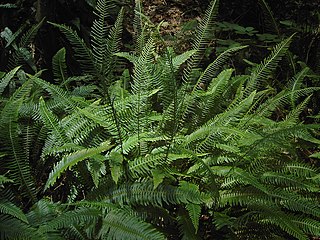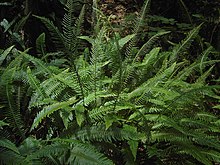
Matteuccia is a genus of ferns with one species: Matteuccia struthiopteris. The species epithet struthiopteris comes from Ancient Greek words στρουθίων (strouthíōn) "ostrich" and πτερίς (pterís) "fern".

Onoclea is a genus of plants in the family Onocleaceae, native to moist habitats in eastern Asia and eastern North America. They are deciduous ferns with sterile fronds arising from creeping rhizomes in spring, dying down at first frost. Fertile fronds appear in late summer. Depending on the authority, the genus contains one to five species.

Blechnaceae is a family of ferns in the order Polypodiales, with a cosmopolitan distribution. Its status as a family and the number of genera included have both varied considerably. In the Pteridophyte Phylogeny Group classification of 2016, the family has 24 genera, and excludes genera placed in the separate family Onocleaceae. The family is divided into three subfamilies, including Blechnoideae s.s. Alternatively, the entire family may be treated as the subfamily Blechnoideae s.l. of a very broadly defined family Aspleniaceae, and include genera others place in Onocleaceae.

Lomaria is a genus of ferns belonging to the family Blechnaceae.

Pteridaceae is a family of ferns in the order Polypodiales, including some 1150 known species in ca 45 genera, divided over five subfamilies. The family includes four groups of genera that are sometimes recognized as separate families: the adiantoid, cheilanthoid, pteridoid, and hemionitidoid ferns. Relationships among these groups remain unclear, and although some recent genetic analyses of the Pteridales suggest that neither the family Pteridaceae nor the major groups within it are all monophyletic, as yet these analyses are insufficiently comprehensive and robust to provide good support for a revision of the order at the family level.
Frond dimorphism refers to a difference in ferns between the fertile and sterile fronds. Since ferns, unlike flowering plants, bear spores on the leaf blade itself, this may affect the form of the frond itself. In some species of ferns, there is virtually no difference between the fertile and sterile fronds, such as in the genus Dryopteris, other than the mere presence of the sori, or fruit-dots, on the back of the fronds. Some other species, such as Polystichum acrostichoides, or some ferns of the genus Osmunda, feature dimorphism on a portion of the frond only. Others, such as some species of Blechnum and Woodwardia, have fertile fronds that are markedly taller than the sterile. Still others, such as Osmunda cinnamomea, or plants of the family Onocleaceae, have fertile fronds that are completely different from the sterile.

Woodwardia is a genus of ferns in the family Blechnaceae, in the suborder Aspleniineae of the order Polypodiales. Species are known as chain ferns. The genus is native to warm temperate and subtropical regions of the Northern Hemisphere. They are large ferns, with fronds growing to 50–300 cm long depending on the species. The fossil record of the genus extends to the Paleocene.

Blechnum, known as hard fern, is a genus of ferns in the family Blechnaceae, subfamily Blechnoideae, according to the Pteridophyte Phylogeny Group classification of 2016. Two very different circumscriptions of the genus are used by different authors. In the PPG I system, based on Gasper et al. (2016), Blechnum is one of 18 genera in the subfamily Blechnoideae, and has about 30 species. Other sources use a very broadly defined Blechnum s.l., including accepting only two other genera in the subfamily. The genus then has about 250 species. In the PPG I circumscription, the genus is mostly neotropical, with a few southern African species.

Onocleaceae is a small family of terrestrial ferns in the order Polypodiales. It is placed in the suborder Aspleniineae in the Pteridophyte Phylogeny Group classification of 2016. Alternatively, the family, along with Blechnaceae, may be placed in a very broadly defined family Aspleniaceae as the subfamily Blechnoideae. The family may contain from one to four genera, consisting of five species largely in north temperate climes. The four genera, Matteuccia, Onoclea, Onocleopsis and Pentarhizidium, may be included under the single genus Onoclea.

Neoblechnum is a genus of ferns in the family Blechnaceae, subfamily Blechnoideae, with a single species Neoblechnum brasiliense, according to the Pteridophyte Phylogeny Group classification of 2016. The genus is accepted in a 2016 classification of the family Blechnaceae, but other sources sink it into a very broadly defined Blechnum, equivalent to the whole of the PPG I subfamily; the species is then known as Blechnum brasiliense. It is called Brazilian dwarf tree fern, red Brazilian tree fern, and red dwarf tree fern.

Lomaria nuda, commonly known as the fishbone waterfern, is a fern that grows up to a metre tall, and is abundant in rainforest and eucalyptus forests in eastern Australia. The species is placed in the genus Lomaria in the Pteridophyte Phylogeny Group classification of 2016, but is often retained in genus Blechnum as Blechnum nudum.

Homalosorus is a genus of fern with only one species, Homalosorus pycnocarpos. It may also be referred to by its older synonyms Athyrium pycnocarpon and Diplazium pycnocarpon. Commonly referred to as the narrow-leaved glade fern, narrow-leaved-spleenwort, or glade fern, it is endemic to eastern North America and typically grows in moist woodlands. Once classified in the family Athyriaceae due to its linear, often doubled sori, in the Pteridophyte Phylogeny Group classification of 2016, it is placed in the small family Diplaziopsidaceae, whose other three species are native to east Asia. Other sources place the genus in the subfamily Diplaziopsidoideae of a very broadly defined family Aspleniaceae, equivalent to the suborder Aspleniineae in PPG I.

Struthiopteris is a genus of ferns belonging to the family Blechnaceae, subfamily Blechnoideae.

Anchistea is a genus of leptosporangiate ferns in the family Blechnaceae. It has only one species, Anchistea virginica the Virginia chain fern, which has long creeping, scaly, underground stems or rhizomes giving rise to tall widely separated, deciduous, single leaves. In contrast, the leaves of Osmundastrum cinnamomeum, which can be mistaken for A. virginica, grow in a group from a crown. Also in contrast to O. cinnamomeum the leaves are monomorphic without distinct fertile fronds. The lower petiole or stipe is dark purple to black, shiny and swollen, the upper rachis is dull green. The leaf blade is green and lanceolate, composed of 12 to 23 paired, alternate pinnatifid pinnae. The pinnae are subdivided into 15 to 20 paired segments that are ovate to oblong. The lower rachis is naked for about half its length. The sori or spore-producing bodies are found on the underside of the pinnae and are long and form a double row which outlines the major veins of the pinnae. In common with all ferns, A. virginica exhibits a gametophyte stage in its life cycle and develops a haploid reproductive prothallus as an independent plant. The spores are produced in red-brown sori which line the spaces (areolae) between the costa and costules. Further photographs can be found at the Connecticut Botanical Society and Ontario Ferns websites.

Diploblechnum is a genus of ferns in the family Blechnaceae, subfamily Blechnoideae, according to the Pteridophyte Phylogeny Group classification of 2016. The genus is accepted in a 2016 classification of the family Blechnaceae, but other sources sink it into a very broadly defined Blechnum, equivalent to the whole of the PPG I subfamily.

Oceaniopteris is a genus of ferns in the family Blechnaceae, subfamily Blechnoideae, according to the Pteridophyte Phylogeny Group classification of 2016. The genus is accepted in a 2016 classification of the family Blechnaceae, but other sources sink it into a very broadly defined Blechnum, equivalent to the whole of the PPG I subfamily.
Blechnidium is a genus of ferns in the family Blechnaceae, subfamily Blechnoideae, with a single species Blechnidium melanopus, according to the Pteridophyte Phylogeny Group classification of 2016. The genus is accepted in a 2016 classification of the family Blechnaceae, but other sources sink it into a very broadly defined Blechnum, equivalent to the whole of the PPG I subfamily.

Brainea is a genus of ferns in the family Blechnaceae, subfamily Blechnoideae, with a single species Brainea insignis, according to the Pteridophyte Phylogeny Group classification of 2016. The genus is accepted in a 2016 classification of the family Blechnaceae, but other sources sink it into a very broadly defined Blechnum, equivalent to the whole of the PPG I subfamily.
Cleistoblechnum is a genus of ferns in the family Blechnaceae, subfamily Blechnoideae, with a single species Cleistoblechnum eburneum, according to the Pteridophyte Phylogeny Group classification of 2016. The genus is accepted in a 2016 classification of the family Blechnaceae, but other sources sink it into a very broadly defined Blechnum, equivalent to the whole of the PPG I subfamily.

Icarus is a genus of ferns in the family Blechnaceae, subfamily Blechnoideae, with a single species Icarus filiformis, according to the Pteridophyte Phylogeny Group classification of 2016. The genus is accepted in a 2016 classification of the family Blechnaceae, but other sources sink it into a very broadly defined Blechnum, equivalent to the whole of the PPG I subfamily.



















